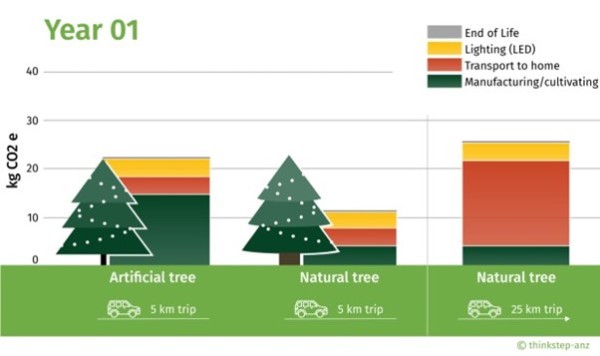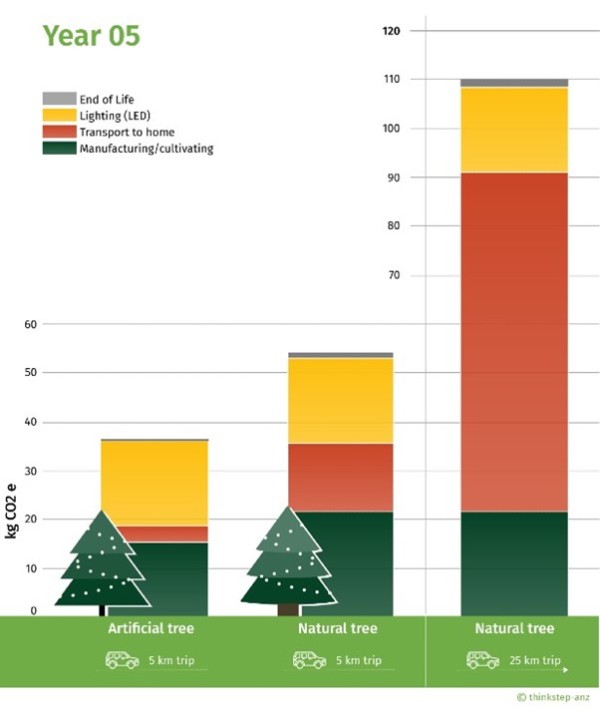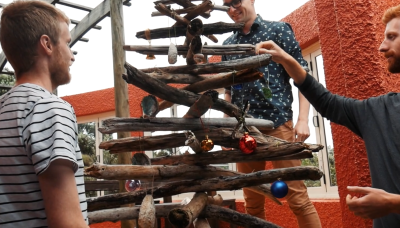Real or artificial, there is nothing imaginary about the environmental impact of Christmas trees. Indeed, with a growing awareness around the impacts of our consumer choices, the public should know what performs better from an environmental perspective. Is one option definitively better? We put it to the test with a comparative life cycle assessment (LCA) study. The results may not be what you expect.
The age-old debate of real versus fake Christmas trees becomes even more heated once you add sustainability into the mix. Fortunately, LCA studies have been tackling this question for over a decade. The general verdict: the environmental impact of a Christmas tree depends on a range of factors, with lifespan and end-of-life processes being some of the biggest indicators.
We drew on a 2010 LCA (PE Americas) that compares the impacts of a real and fake tree, as well as two more recent LCA studies from WAP Sustainability Consulting and ESU Services. We also added LED string lights to our tree, estimated to be in use for 4 hours a day for 20 days to round out the Christmas season. While there is limited comparability between the two earlier studies, our results indicated similar trends overall. These include:
1. The significant impact of end-of-life options for the overall footprint of trees
2. A ‘breakeven’ point of around 5 years for when artificial trees become a lower environmental impact option
The bottom-line
Choose whichever tree you like, however keep in mind a few easy ways to lower the impact of your chosen tree. For plastic trees, choose a high-quality option that you can keep for as long as possible. An artificial tree that is used for five or more Christmases generally outperforms its real counterpart in the sustainability department. Staying away from short-lived Christmas tree trends such as neon or white Christmas trees can also help to increase the longevity of plastic trees.


For real trees, don’t make a long journey specifically to buy one. Try to opt for local or nearby options instead. The use of pesticides and fertilisers, and types of land and water use, may lead to a higher environmental impact for trees bought from a plantation in comparison to trees from forestry. A Swiss study suggests that a fir tree from a plantation is also likely to have a much higher environmental impact than one from forestry without any pesticides or fertilisers.
The ultimate green tree
 For those who want to celebrate Christmas/spread the Christmas cheer year-round, why not opt for a potted Christmas tree that you can re-use year after year? For those after an even lower impact, or just something a little different, create a tree out of existing natural materials like the driftwood Christmas tree put together by the thinkstep-anz team. Decorations include pāua shells, woven grass, and anything else that can be sourced from your local beach. While we used a normal drill to assemble the tree, the more ambitious among us could lower their impact to almost zero by using a hand drill!
For those who want to celebrate Christmas/spread the Christmas cheer year-round, why not opt for a potted Christmas tree that you can re-use year after year? For those after an even lower impact, or just something a little different, create a tree out of existing natural materials like the driftwood Christmas tree put together by the thinkstep-anz team. Decorations include pāua shells, woven grass, and anything else that can be sourced from your local beach. While we used a normal drill to assemble the tree, the more ambitious among us could lower their impact to almost zero by using a hand drill!
And last but not least, while the discussions around Christmas sustainability often come back to the tree, Christmas based gifts, meals, and travelling can have a much higher impact on the holiday season so try to consider what is most important this holiday season.